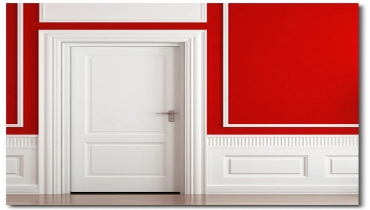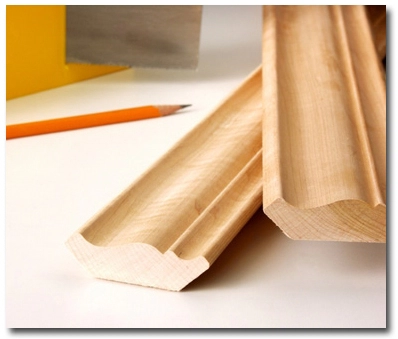Trim Molding | Choosing the Right Type of Molding

Trim molding dates back to the buildings of ancient Greek and Roman civilizations, and it continues to be a common sight in today's homes. The decorative device not only hides imperfections and serves as a transition between different materials, such as paint and wallpaper, it also adds architectural interest to a room. Learn more about the different types of trim molding and their materials before creating a décor plan for your home.
Places to Install Trim Molding
What is Crown Molding? - This type of molding fits between the wall and ceiling of a room, and options range from basic to decorative. Decorative molding includes dental crown molding featuring a thin band with symmetrical rectangles or squared-off beads; Federal, Georgian and Early Classic Revival architectural styles most often use this type of molding.
Cavetto Molding is another style of decorative molding. It features a concave shape with a quarter-round circle, the top part of which extends over the lower portion, and can be found in classic architectural styles. Greek egg and dart molding also proves popular today, with its alternating V and oval shapes.
What is Door Trim? - This type of molding also ranges from simple to more elaborate, with the latter creating a decorative frame around the door. An architecturally pleasing doorway will feature rosettes at the top corners and plinth blocks at the bottom. These decorative devices also make it easier to join door casings and baseboard molding, hiding seams from sight.
What is Baseboard Molding? - Because of its location, basic rules when it comes to baseboard molding. As noted above, it hides the transition between floor material and sheetrock. Whether tile, stone, carpet or hardwood, a floor material will need a cover where it meets the wall to hide the unsightly transition.
What is Window Trim? - Just as with door trim, the molding found around a window can be functional but also decorative. A beautifully framed window can become a focal point in a room, displaying a stunning view just as a homeowner would a painting. When deciding on the type of molding and style you want in your home, keep its architecture style in mind and choose trim molding that complements, not competes with your home's bones. Molding can easily overpower a room or seem out of place if not chosen with care.
Types of Trim Molding Materials

Unfinished Solid Wood Trim - Made from pine or hardwood, wood trim proves the most common type of molding used today. It comes in a multitude of basic styles and as stain-grade or paint-grade molding. Stain-grade molding comes from clear lumber without knots and other defects, allowing you to achieve an even finish without streaking or blotching. Paint-grade molding uses short pieces of pine joined together, which makes it unsuitable for stain. It typically comes preprimed for painting.
Unfinished Decorative Wood Trim - This hardwood molding is of a quality to accept staining, clear coating or painting. It also comes in a wide variety of embossed patterns and profiles.
Foam Molding - Made from a strong, lightweight foam, this type will not warp or shrink, both issues with wood molding. It easily installs with caulk instead of hammer and nails. No primer is required, and foam molding also comes in a variety of styles.
Vinyl Molding - This durable molding uses polystyrene and comes prefinished in a selection of different wood grain patterns and finishes, including white. It will not warp or shrink, and it also proves less expensive and easier to install than wood molding.
Metal/Aluminum Molding - The look of metal and aluminum molding suits industrial settings and exteriors for the most part, though it could fit into the architectural style of an ultra-modern home. They typically are finished at the factory with a baked-on protective coating.
Now that you have a better understanding of the world of trim molding, you might still want help deciding on the style and material. Your professional handyman has the knowledge required to guide you in these important design decisions and will steer you away from decorative moldings and trim that don't complement the existing architecture of your home or that won't suit the environment in your area of the country.
Your professional handyman also can provide the installation required to make the most of these decorative devices. Where they go and how neatly they get installed makes all the difference not only in your enjoyment of moldings and trim but also the resale value of your home. Utilize his or her expertise for the best possible results.
This article is part of the Crown Molding Installation series. Read more for more molding and trim ideas and tips from Mr. Handyman.
Mr. Handyman can maintain your home to save you money. One call really does take care of everything on your to-do list. Make sure to stay on top of all your household repairs, improvements and maintenance needs and request service now online.
Repair. Improve. Maintain. One call does it all!
 Click to call
Click to call


